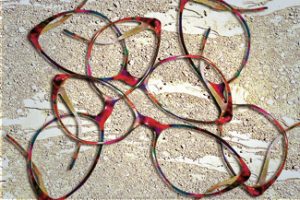Which optical lenses are best for children?
If you are purchasing new eyeglasses for your child, you may not even be aware that different lens options exist.
While your optometrist will be able to guide you and recommend a specific type of lens for your child’s individual needs, it is a good idea to familiarize yourself with the different lens materials.
The following is a guide to the most common lenses for children. However, if your child has a high optical prescription (above 2.00 diopters) then high-index lenses may be recommended as well.
Polycarbonate
Polycarbonate is the most popular choice for children’s eyewear— from eyeglasses to sports goggles and sunglasses.
These lenses can withstand the active play children are involved in on a daily basis, and protect your child’s eyes as they engage in different physical activities.
While not completely indestructible, polycarbonate is the strongest plastic lens material available, and is widely known for its high impact resistance, durability and built-in UV protection.
Polycarbonate lenses have a refractive index of 1.59, so are thinner and lighter than regular plastic (CR-39) lenses, making them a comfortable choice for children.
However, while these lenses can be beneficial in many different ways, it is important to know that polycarbonate lenses may not provide the clearest vision, especially when compared to other plastic lenses.
Trivex
Trivex plastic is another common lens material used for children.
Trivex lenses are similar to polycarbonate lenses as they are also impact resistant and provide adequate protection from eye injuries. These lenses have a refractive index of 1.53 and are therefore also thinner, lighter and more comfortable than regular plastic lenses.
Trivex lenses provide clearer vision than polycarbonate lenses, with less visual distortion.
The downside to trivex lenses is that this material doesn’t offer a wide selection of lens designs when compared to CR-39 and polycarbonate lenses— so if your child requires a bifocal or multifocal lens, trivex may not be the right choice.
Another detail to keep in mind is that with all of its advantages, trivex can also be slightly more expensive. This may influence your decision when choosing between trivex, polycarbonate, and CR-39 lenses.
If your child needs glasses, speak with an optometrist to learn more about your lens options.
SEE RELATED: Guide to High-Index Lenses
Columbia resin 39 (CR-39)
CR-39 is the most common lens material used for children.
This type of plastic is both lightweight and thin, although it is slightly heavier than polycarbonate and trivex lenses.
Scratch resistant and hard coatings can be easily applied to these lenses, which helps to protect them and increase their longevity. CR-39 lenses also provide slightly less distortion than polycarbonate lenses, and therefore offer sharper visual clarity— similar to trivex lenses.
CR-39 doesn’t naturally provide UV protection like polycarbonate lenses do, so it is generally recommended to add a UV protection coating to ensure that your child’s eyes are protected from the sun’s UV rays.
A downside to CR-39 is that it is not as durable and scratch resistant as polycarbonate or trivex lenses— something to keep in mind if your child is involved in a lot of active play.
For this reason, CR-39 is generally only recommended for older children and adults, or if you are on a tight budget.
Transition lenses
Transition lenses, also known as photochromic lenses, are eyeglasses that remain clear for indoor use, but automatically darken when exposed to sunlight. These lenses are a great option for children, as they could eliminate the need for sunglasses.
Which type of lens is right for your child?
Now that you know the different options available, you will be more informed when discussing your child’s new eyeglasses with your optometrist or their staff.
Each type of lens has its advantages and disadvantages, and the lens type that you choose is really a personal choice.
Which lenses are most impact resistant?
Children are notorious for breaking their glasses. It’s a sad reality, especially when numerous pairs of glasses begin to make a dent in your wallet. Not only do eyeglass frames break or bend out of shape, but the lenses themselves can get scratched and damaged — if they aren’t properly cared for.
So how do you know which type of lens is best for your child?
Polycarbonate vs CR39 vs Trivex
If your child is young and active, be sure to choose a lens material that offers both safety and durability, such as polycarbonate or trivex plastic. This will help to reduce any concerns you may have about your child wearing their glasses at school, on the playground or the sports field.
Children that are involved in sports can also benefit from wearing prescription sports goggles, which offer eye protection and visual clarity while they play.
In this case, CR-39 lenses may be recommended for indoor use— at home and in the classroom— while their sports goggles can be worn outdoors on the sports field.
LEARN MORE: Optical and Contact Lenses
If you have any questions about purchasing new eyeglasses for your child, you can always speak with an optometrist.
Your eye doctor can advise which type of lens is best for your child based on their individual needs.










